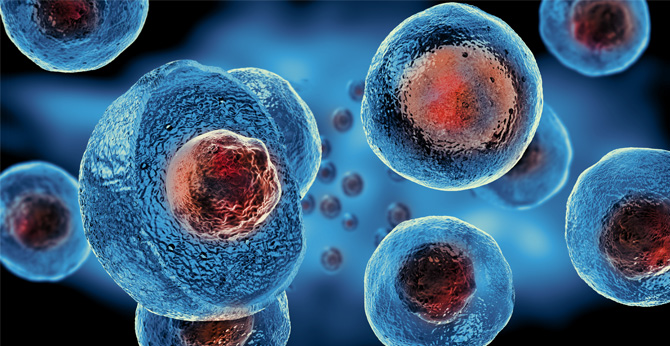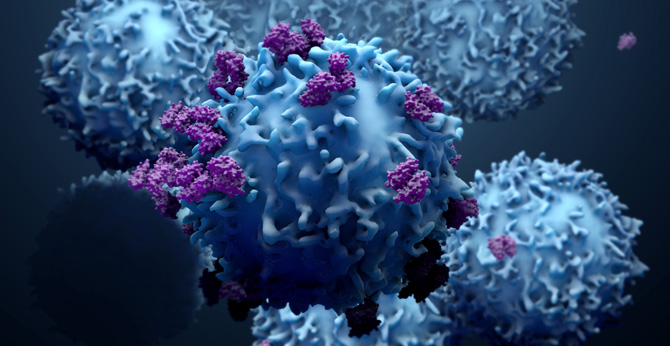All products and services are For Research Use Only and CANNOT be used in the treatment or diagnosis of disease.
The CD44 antigen is a cell-surface glycoprotein involved in cell–cell interactions, cell adhesion and migration. In humans, the CD44 antigen is encoded by the CD44 gene on Chromosome 11. CD44 is expressed in a large number of mammalian cell types. CD44 participates in a wide variety of cellular functions including lymphocyte activation, recirculation and homing, hematopoiesis, and tumor metastasis. it is responsible for mediating communication and adhesion between adjacent cells and between cells and the extracellular matrix (ECM). In addition to its role in cellular adhesion, CD44 can direct intracellular signaling for growth and motility, and thus it is involved in many types of cancers, including breast, lung, prostate, ovarian, cervical, and colorectal cancers and neuroblastoma.
 Associated Disease
Associated Disease
 Loading...
Loading...
| CAT | Product Name | Target Species | Antibody Clone | Antibody Host | Receptor Construction | Vector Type | Targeting Cell Type | CAR Vector Type | Inquiry & Datasheet |
| CAR-CQ0228 | Anti-CD44 (1A9.A6.B9) h(41BB-CD3ζ) CAR, pCDCAR1 | Human, Baboon, Primate | 1A9.A6.B9 | Human | scFv-41BB-CD3ζ | Lentiviral vector | T cell | ||
| CAR-CQ0229 | Anti-CD44 (Bivatuzumab) h(41BB-CD3ζ) CAR, pCDCAR1 | Human, Mouse | Bivatuzumab | Mouse | scFv-41BB-CD3ζ | Lentiviral vector | T cell | ||
| CAR-CQ0230 | Anti-CD44 (RG7356) h(41BB-CD3ζ) CAR, pCDCAR1 | Human | RG7356 | Humanized | scFv-41BB-CD3ζ | Lentiviral vector | T cell | ||
| CAR-CQ0231 | Anti-CD44 (LGadh01-01) h(41BB-CD3ζ) CAR, pCDCAR1 | Human | LGadh01-01 | Rat | scFv-41BB-CD3ζ | Lentiviral vector | T cell | ||
| CAR-CQ0232 | Anti-CD44 (huPTA-4621) h(41BB-CD3ζ) CAR, pCDCAR1 | Human, Mouse | huPTA-4621 | Humanized | scFv-41BB-CD3ζ | Lentiviral vector | T cell | ||
| CAR-CQ0233 | Anti-CD44 (14G9.B8.B4) h(41BB-CD3ζ) CAR, pCDCAR1 | Human | 14G9.B8.B4 | Human | scFv-41BB-CD3ζ | Lentiviral vector | T cell | ||
| CAR-CQ0234 | Anti-CD44 (14G9) h(41BB-CD3ζ) CAR, pCDCAR1 | Human, Mouse | 14G9 | Human | scFv-41BB-CD3ζ | Lentiviral vector | T cell | ||
| CAR-CQ0235 | Anti-CD44 (mH460-16-2) h(41BB-CD3ζ) CAR, pCDCAR1 | Human, Primate | mH460-16-2 | Mouse | scFv-41BB-CD3ζ | Lentiviral vector | T cell | ||
| CAR-CQ0236 | Anti-CD44 (2D1) h(41BB-CD3ζ) CAR, pCDCAR1 | Human, Mouse, Cattle, Goat, Rabbit, Sheep | 2D1 | Human | scFv-41BB-CD3ζ | Lentiviral vector | T cell | ||
| CAR-CQ0237 | Anti-CD44 (1A9) h(41BB-CD3ζ) CAR, pCDCAR1 | Human, Mouse, Dog, Horse, Cat | 1A9 | Human | scFv-41BB-CD3ζ | Lentiviral vector | T cell | ||
| CAR-CQ0238 | Anti-CD44 (LGadh01-02) h(41BB-CD3ζ) CAR, pCDCAR1 | Human, Pig, Dog | LGadh01-02 | Rat | scFv-41BB-CD3ζ | Lentiviral vector | T cell | ||
| CAR-CQ0239 | Anti-CD44 (chPTA-4621) h(41BB-CD3ζ) CAR, pCDCAR1 | Human | chPTA-4621 | Mouse | scFv-41BB-CD3ζ | Lentiviral vector | T cell | ||
| CAR-CQ0240 | Anti-CD44 (2D1.A3.D12) h(41BB-CD3ζ) CAR, pCDCAR1 | Human | 2D1.A3.D12 | Human | scFv-41BB-CD3ζ | Lentiviral vector | T cell | ||
| CAR-CQ0241 | Anti-CD44 (HI44a) h(41BB-CD3ζ) CAR, pCDCAR1 | Human, Baboon, Monkey | HI44a | Mouse | scFv-41BB-CD3ζ | Lentiviral vector | T cell | ||
| CAR-CQ0242 | Anti-CD44 (B2954) h(41BB-CD3ζ) CAR, pCDCAR1 | Human | B2954 | Mouse | scFv-41BB-CD3ζ | Lentiviral vector | T cell | ||
| CAR-CQ0243 | Anti-CD44 (B2955) h(41BB-CD3ζ) CAR, pCDCAR1 | Human | B2955 | Mouse | scFv-41BB-CD3ζ | Lentiviral vector | T cell | ||
| CAR-CQ0244 | Anti-CD44 (B2957) h(41BB-CD3ζ) CAR, pCDCAR1 | Human | B2957 | Mouse | scFv-41BB-CD3ζ | Lentiviral vector | T cell | ||
| CAR-CQ0245 | Anti-CD44 (B2958) h(41BB-CD3ζ) CAR, pCDCAR1 | Human | B2958 | Mouse | scFv-41BB-CD3ζ | Lentiviral vector | T cell | ||
| CAR-CQ0246 | Anti-CD44 (H90) h(41BB-CD3ζ) CAR, pCDCAR1 | Human | H90 | Mouse | scFv-41BB-CD3ζ | Lentiviral vector | T cell | ||
| CAR-CQ0247 | Anti-CD44 (F2-1A6) h(41BB-CD3ζ) CAR, pCDCAR1 | Human | F2-1A6 | Mouse | scFv-41BB-CD3ζ | Lentiviral vector | T cell |
 NEWSLETTER
NEWSLETTER
The latest newsletter to introduce the latest breaking information, our site updates, field and other scientific news, important events, and insights from industry leaders
LEARN MORE NEWSLETTER NEW SOLUTION
NEW SOLUTION
CellRapeutics™ In Vivo Cell Engineering: One-stop in vivo T/B/NK cell and macrophage engineering services covering vectors construction to function verification.
LEARN MORE SOLUTION NOVEL TECHNOLOGY
NOVEL TECHNOLOGY
Silence™ CAR-T Cell: A novel platform to enhance CAR-T cell immunotherapy by combining RNAi technology to suppress genes that may impede CAR functionality.
LEARN MORE NOVEL TECHNOLOGY NEW SOLUTION
NEW SOLUTION
Canine CAR-T Therapy Development: From early target discovery, CAR design and construction, cell culture, and transfection, to in vitro and in vivo function validation.
LEARN MORE SOLUTION